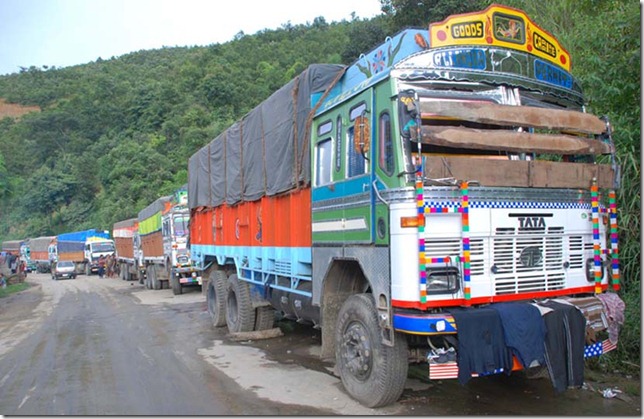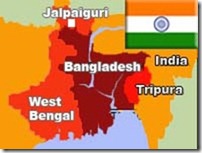
Loaded trucks stranded since July 31 in between Senapati Hq and Karong due to the economic blockade called by the SHDDC.
LPG, petrol and diesel have run dry, there is an acute scarcity of oxygen cylinders and life saving drugs. Prices of essential commodities are skyrocketing due to the forced closure of NH-39 that links capital Imphal with Dimapur in Nagaland, reports Ratnadip Choudhury
N Ramandra Singh and his wife Savitri Devi live in the Singimei locality of Imphal. They have two LPG connections and Ramandra owns a Royal Enfield motorcycle and a Tata Indica car. Yet, these days Savitri does her cooking on logs and charcoal, while her husband rides around in his old bicycle. Lest one think this couple is practicing a fuel conservation campaign, they are not. They are battling a blockade.
Manipur is smarting from an economic blockade – the latest from what has now become regular annual fare – that started on 31 July 2011 and another counter blockade from 21 August 2011. LPG, petrol and diesel have run dry, there is an acute scarcity of oxygen cylinders and life saving drugs and prices of essential commodities are skyrocketing due to the forced closure of NH-39 that links capital Imphal with Dimapur in Nagaland.
The bone of contention is the possibility of the creation of a new district – the Special Area Demarcated Autonomous Region (SADAR) hills – carving out three sub-divisions of Kangpokpi, Saikul and Saitu Gamphazol from the district of Senapati. The demand for creation of the SADAR hills district has been a long standing one from the Kuki tribe and is spearheaded by the SADAR Hill Districthood Demand Committee (SHDDC). On the other hand, the Nagas living in the four hill districts of Manipur – Ukhrul, Tamenglong, Chandel and Senapati – are vehemently opposed to the idea as they do not want any bifurcation of Naga inhabited areas in the state.
The apex Naga body in Manipur, the United Naga Council (UNC), is adamant that it will not give an inch of land from the Naga villages for the new district. The blockades have made things worse as the Meitieis living in the Imphal valley begrudge the move and might even retaliate. The last nail in the coffin is the failure of the Okram Ibobi Singh government to handle a political demand of creation of a separate district and an administrative problem of forced closure of the national highway differently. It is instead hoping that this too shall pass.
“The least Ibobi should have done is to open the national highway. In the 10 years that he has been CM, Ibobi has taken the state from the frying pan into the fire. Every time a crisis has come, he has waited for it to die down. This might boomerang on him in the ensuing Assembly polls in the state,” observes Rishikanta Sharma, a retired school teacher.
One can sense trouble right from the moment one takes the NH-39 from Imphal. A five kilometre long queue for fuel meets the eye. No other vehicles on the road, hardly any people. In Gamgiphai, scene of the first blockade, roads are dug up, charred vehicles torched by protesters lie at the sides, huge boulders obstruct the stretches – a virtual battle zone. In just a few years, a series of economic blockades has left Manipur’s economy crippled. More than hard reason, it is a politics of emotions and ethnicity that drives the crisis. “Our demand is very much legitimate. Long ago, the Manipur government had cleared the decision of the creation of a separate SADAR Hills district. We just want its implementation. The current government wants political mileage out of the issue, and we will not step back,” reacts Ngamkhohao Haokip, president of SHDDC. In 1982, the Manipur cabinet first decided that the SADAR hills district would be carved out. In 2000, the W Nipamacha Singh cabinet reaffirmed the 1982 decision of the creation of SADAR hills, but subsequent Congress governments have put it in cold storage.
“My firm stand is that it (SADAR Hills) has to be given with some adjustments in the boundary. It was there during the British rule. SADAR Hills was also there during the commissioner’s rule, with some villages from here and there, which disturbed the compactness of the hills. That can still be rectified. If that compact area can be demarcated for them, they can have it,” says former chief minister and Rajya Sabha MP Rishang Keishing. “There is no question of it going against Nagas because we are from the same state. They are no newcomers.” But the Nagas are unrelenting. “The Naga people need to be consulted. The Manipur government cannot go against the MoU and it seems that Ibobi is trying to divide the hill tribes. He will pay for it in the ensuing Assembly polls. He should not dare the Naga unity, we are not against the Kuki but they have to understand that they are playing into Ibobi’s hands,” reacts a top UNC leader from Senapati on condition of anonymity. The MoU he mentions was signed on 10 November 1992, where the Manipur government had committed to promote basic human rights and to assiduously work to ensure the peaceful co-existence of the tribals, particularly the Nagas staying in Manipur. The Nagas feel that bifurcation of Naga-inhabited areas would be a breach of that agreement.
The Kuki’s hit back. “We are not asking for a separate homeland, we are only asking for a new district for better development of the area. The Nagas and the government should not oppose it,” says 57-year-old Phalneiting Sitlhou from Kangpokpi, the proposed headquarters of SADAR hills district.
The buck clearly stops at Ibobi Singh. A high-level committee has been led by Chief Secretary DS Poonia to look into the SADAR Hills district issue and pass a resolution in the Assembly for the creation of a district boundary commission. The high level committee has been given three months to come up with its report but by then Manipur might go for early polls. All this makes it seem as if the CM is trying to buy time. Although the opposition parties in the state are high on rhetoric, Ibobi is actually enjoying the luxury of having no strong alternative in the state. But, there are 20 tribal seats at stake. “If the economic blockade continues for another month, then the people might lose patience,” warns Pradip Phanjoubam, editor of Imphal Free Press. “The state is yet to fully recover from last year’s 68 days blockade and this could have been avoided. Civil society in Imphal will not remain silent, then it will become even more difficult for the state government.”
Although the creation of a district will not put administrative blocks, what could be a problem is that in Manipur all the revenue districts are in the valley and the non-revenue districts are in the hills. SADAR Hills includes some areas of the valley too. Demarcating land in the hills therefore could mean a stiff resistance from the Meitei farmers residing there. Watchers believe the government can handle this prudently but the larger question remains whether the government has any prudence at all.
Perhaps Manipur needs a separate administrative set up to bring back trust among communities, but for now all eyes on Ibobi if he can get the national highway opened.
With inputs from Sharatchandra Sharma in Imphal and Prakhar Jain in New Delhi
Ratnadip Choudhury is a Principal Correspondent with Tehelka. ratnadip@tehelka.com






























